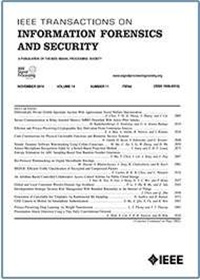电力系统调频中数据完整性隐身攻击的识别与缓解
IF 8
1区 计算机科学
Q1 COMPUTER SCIENCE, THEORY & METHODS
IEEE Transactions on Information Forensics and Security
Pub Date : 2025-06-11
DOI:10.1109/TIFS.2025.3578922
引用次数: 0
摘要
负载频率控制在电力系统中的应用对提高系统的稳定性具有重要作用。然而,作为一个依赖于通信网络的系统,LFC应用程序中包含了自动生成控制服务,这使得LFC系统容易受到网络威胁。通过通信网络伪造测量和控制信号,称为数据完整性攻击(DIAs),可以严重影响系统的动态性能。研究了隐身DIAs下互联电力系统的频率调节问题。为此,提出了一种由动态乘法水印技术、估计器、异常检测器和触发机制组成的识别方案。水印的概念是有意地将水印信号叠加到通过通信网络传输的源信号上。实现这一目标需要使用特定的水印滤波器,其结果是运营商在调节传输信号方面获得更大的灵活性,这反过来又提供了更好的信号完整性。在本文提出的识别方案中,存在一种乘法叠加,即网络另一端的水印均衡滤波器可以抵消水印的影响,从而恢复原始信号。该触发机制在识别攻击后,阻断被操纵的ACE信号,并将估计的ACE信号提交给从控制器。采用无模型滑模控制方法作为二次频率控制器,在DIAs、负载干扰和物理限制下调节系统频率。基于speedgoat的实时仿真结果表明,与其他防御技术相比,所开发的防御方法能够及时识别隐身dia,并显著改善系统在这些攻击下的动态响应。本文章由计算机程序翻译,如有差异,请以英文原文为准。
Identification and Mitigation of Data Integrity Stealth Attacks in Frequency Regulation of Power Systems
Load frequency control (LFC) application in power systems has an essential role in improving the system’s stability. However, the presence of the automatic generation control service incorporated into the LFC application, being a system dependent on communication networks, makes the LFC system susceptible to cyber threats. Falsifying measurement and control signals through communication networks, known as data integrity attacks (DIAs), can severely affect the system’s dynamic performance. This paper studies the frequency regulation issue of an interconnected power system under stealth DIAs. Accordingly, a novel identification scheme consisting of the dynamic multiplicative watermarking technique, an estimator, an anomaly detector, and a trigger mechanism is introduced to identify the DIAs. The watermarking concept is the intentional overlay of a watermark signal onto the source signal transmitted through the communication network. Achieving this requires using a specific watermarking filter, and the result is that operators gain greater flexibility in regulating the transmitted signals, which in turn provides improved signal integrity. In the proposed identification scheme, there is a multiplicative superimposition, where the watermark equalizing filter on the opposite end of the network can cancel out the impact of the watermarking, leading to the retrieval of the original signal. After identifying the attack, the proposed trigger mechanism blocks the manipulated ACE signal and submits the estimated ACE signal to the secondary controller. A model-free sliding mode control method is also implemented as the secondary frequency controller to regulate the system’s frequency under DIAs, load disturbances, and physical limitations. The Speedgoat-based real-time simulation results reveal that the developed defense method can timely identify stealth DIAs and significantly improve the system’s dynamic responses compared to the other techniques under these attacks.
求助全文
通过发布文献求助,成功后即可免费获取论文全文。
去求助
来源期刊

IEEE Transactions on Information Forensics and Security
工程技术-工程:电子与电气
CiteScore
14.40
自引率
7.40%
发文量
234
审稿时长
6.5 months
期刊介绍:
The IEEE Transactions on Information Forensics and Security covers the sciences, technologies, and applications relating to information forensics, information security, biometrics, surveillance and systems applications that incorporate these features
 求助内容:
求助内容: 应助结果提醒方式:
应助结果提醒方式:


